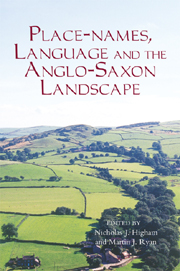Book contents
- Frontmatter
- Contents
- List of Illustrations
- Acknowledgements
- List of Contributors
- Abbreviations
- 1 Place-Names, Language and the Anglo-Saxon Landscape: An Introduction
- 2 The Landscape of Place-Name Studies
- 3 Place-Names as Travellers' Landmarks
- 4 Light thrown by Scandinavian Place-Names on the Anglo-Saxon Landscape
- 5 Language and the Anglo-Saxon Landscape: Towards an Archaeological Interpretation of Place-Names in Wiltshire
- 6 Hunting the Vikings in South Cumbria from Ambleside to Haverbrack
- 7 Viking-Age Amounderness: A Reconsideration
- 8 The Woodland Landscape of Early Medieval England
- 9 The Pre-Conquest Lands and Parish of Crediton Minster, Devon
- 10 Rewriting the Bounds: Pershore's Powick and Leigh
- 11 That ‘Dreary Old Question’: The Hide in Early Anglo-Saxon England
- 12 Boroughs and Socio-Political Reconstruction in Late Anglo-Saxon England
- Index
1 - Place-Names, Language and the Anglo-Saxon Landscape: An Introduction
Published online by Cambridge University Press: 05 February 2013
- Frontmatter
- Contents
- List of Illustrations
- Acknowledgements
- List of Contributors
- Abbreviations
- 1 Place-Names, Language and the Anglo-Saxon Landscape: An Introduction
- 2 The Landscape of Place-Name Studies
- 3 Place-Names as Travellers' Landmarks
- 4 Light thrown by Scandinavian Place-Names on the Anglo-Saxon Landscape
- 5 Language and the Anglo-Saxon Landscape: Towards an Archaeological Interpretation of Place-Names in Wiltshire
- 6 Hunting the Vikings in South Cumbria from Ambleside to Haverbrack
- 7 Viking-Age Amounderness: A Reconsideration
- 8 The Woodland Landscape of Early Medieval England
- 9 The Pre-Conquest Lands and Parish of Crediton Minster, Devon
- 10 Rewriting the Bounds: Pershore's Powick and Leigh
- 11 That ‘Dreary Old Question’: The Hide in Early Anglo-Saxon England
- 12 Boroughs and Socio-Political Reconstruction in Late Anglo-Saxon England
- Index
Summary
not all words were established by the ancients from nature; some were established by whim, just as we sometimes give names to our slaves and possessions according to what tickles our fancy.
That the words people used and the names they gave to things are of significance to those who study the past is no great insight. What these names and words can tell us and how we should find this out, however, have been and will continue to be subject to intense debate. Medievalists, used to dealing with sources written in dead or ancestor languages, have long been aware of the problems of both what words mean and how meaning is created socially and historically, though unsurprisingly the approaches to these problems have varied considerably over time. The essays collected in this volume – one of two arising from a conference held at the University of Manchester in 2007 under the auspices of the Manchester Centre for Anglo-Saxon Studies (MANCASS) – all explore, in different ways, how the inhabitants of Anglo-Saxon England described and understood their physical environment. The evidence drawn on is, for the most, linguistic and place-name based, with the historical and/or archaeological evidence predominantly covered in another volume. That said, as many of the chapters make clear, such disciplinary boundaries are often only a matter of editorial convenience; despite all its methodological problems and challenges, interdisciplinarity remains our best hope for understanding the Anglo-Saxon landscape.
- Type
- Chapter
- Information
- Place-names, Language and the Anglo-Saxon Landscape , pp. 1 - 22Publisher: Boydell & BrewerPrint publication year: 2011



